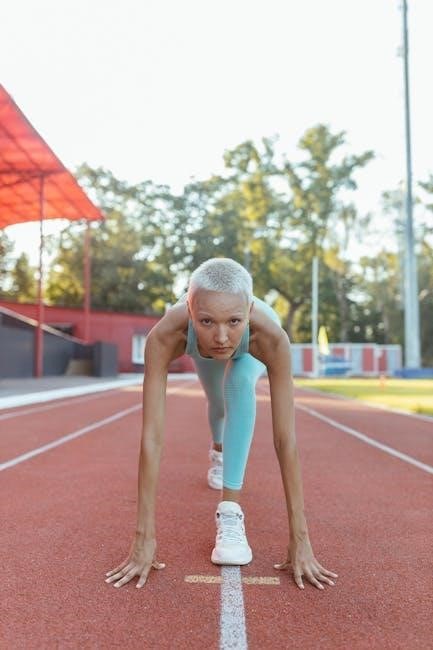
speed and agility training program pdf
Speed and Agility Training Program (PDF)

This comprehensive program enhances athletic performance through structured drills focusing on speed, agility, and quickness. It incorporates strength training, plyometrics, and metabolic conditioning. Evaluating athlete readiness is crucial before commencing the program, ensuring safe and effective progression.
Speed, agility, and quickness (SAQ) training is vital for athletes across various sports, enhancing their ability to perform effectively. Speed refers to straight-ahead velocity, crucial for linear movements. Agility involves rapidly changing direction without losing balance, relying on strength, balance, and coordination. Quickness denotes reaction time and decision-making speed.
SAQ training aims to improve an athlete’s explosive power and coordination. The programming component of SAQ training mirrors reactive training principles. Effective SAQ programs integrate fast feet/coordination, plyometric, and agility drills. These drills activate fast-twitch muscle fibers, enhancing explosiveness. SAQ training develops physical capabilities, improving the athlete’s ability to accelerate, decelerate, and change direction efficiently.
SAQ training isn’t just about running fast; it’s about enhancing overall athleticism. Key coaching points include staying on the balls of the feet and keeping the hips low. Integrating SAQ into an athlete’s routine is fundamental for competitive advantage. It’s essential to ensure athletes are physically prepared for SAQ training demands.
Key Components of an Effective SAQ Program
An effective speed, agility, and quickness (SAQ) program incorporates several key components to maximize athletic performance. First, a dynamic warm-up is crucial to prepare the body for intense activity. This includes mobility exercises that enhance range of motion and reduce the risk of injury. Strength training forms the foundation, improving power output for speed and agility.
Plyometric exercises are essential for developing speed-strength, enabling athletes to generate force quickly. Agility drills focusing on lateral movement and change of direction enhance maneuverability. Speed drills emphasizing linear speed and acceleration are equally important. Quickness drills that improve reaction time and decision-making skills are integrated to boost cognitive processing speed.
Metabolic conditioning ensures athletes can sustain high-intensity efforts throughout a game or competition. Periodization, or structured progression, is critical for optimizing results and preventing overtraining. Furthermore, evaluating an athlete’s readiness ensures they are prepared for the demands of SAQ training. A well-rounded SAQ program addresses all facets of athletic performance, leading to improved speed, agility, and quickness.
Warm-up Methods and Mobility Training
Effective warm-up methods and mobility training are vital for preparing athletes for speed and agility work, reducing injury risk, and enhancing performance. A proper warm-up should gradually increase body temperature, heart rate, and blood flow to the muscles. This can include light cardiovascular activity such as jogging or cycling, followed by dynamic stretching exercises.
Dynamic stretches involve active movements that take joints through their full range of motion, such as leg swings, arm circles, and torso twists. These movements improve flexibility, mobility, and coordination. Mobility training focuses on improving joint range of motion and tissue extensibility. Exercises like hip circles, thoracic rotations, and ankle mobilizations can enhance movement efficiency and reduce stiffness.
Foam rolling can also be incorporated to release muscle tension and improve flexibility. The warm-up should be specific to the demands of the training session, targeting the muscles and joints that will be heavily used. A well-designed warm-up and mobility routine prepares the body for the intense demands of speed and agility training, optimizing performance and minimizing the risk of injury.
Strength Training for Speed and Agility Development
Strength training forms a crucial foundation for speed and agility development, enhancing an athlete’s ability to generate force, accelerate, and change direction efficiently. A well-structured strength program should target key muscle groups involved in sprinting and agility movements, including the legs, core, and upper body.
Exercises like squats, deadlifts, lunges, and plyometrics build lower body strength and power, essential for generating the force needed for acceleration and explosive movements. Core strength is vital for stability and transferring force effectively, so exercises like planks, Russian twists, and medicine ball throws should be incorporated. Upper body strength contributes to overall athleticism and balance, making exercises like push-ups, pull-ups, and rows beneficial.
The weight room is the most effective speed/agility training tool! Strength and Power are the FOUNDATIONS to speed/agility development. Focus on compound movements that engage multiple muscle groups simultaneously. Progressive overload, gradually increasing the weight or resistance, is crucial for continued strength gains. Proper form and technique are essential to prevent injuries and maximize the effectiveness of the training. A well-designed strength training program complements speed and agility drills, leading to improved athletic performance.

Speed-Strength Development and Plyometric Training
Speed-strength, the ability to exert maximal force in minimal time, is paramount for athletes seeking to enhance speed and agility. Plyometric training is a highly effective method for developing speed-strength, bridging the gap between strength and speed by utilizing the stretch-shortening cycle.

Plyometric exercises involve rapid eccentric (muscle lengthening) followed by a rapid concentric (muscle shortening) contraction. This cycle enhances muscle power and explosiveness. Examples include jump squats, box jumps, and depth jumps. These exercises improve the rate of force development, crucial for accelerating, changing direction, and reacting quickly.
When incorporating plyometrics, proper technique and progressive overload are essential to prevent injuries. Start with low-intensity exercises and gradually increase the intensity and volume as the athlete adapts. Ensure adequate rest and recovery between sessions. Combine plyometrics with strength training to maximize speed-strength development. Integrating these modalities creates a potent stimulus for athletic improvement. Focus on exercises that mimic sport-specific movements to ensure transferability of training gains. A well-designed program enhances the athlete’s ability to generate explosive power, leading to enhanced speed and agility performance.
Metabolic Conditioning for Speed and Agility Performance
Metabolic conditioning is crucial for sustaining high-intensity efforts during speed and agility tasks. It enhances the body’s ability to efficiently utilize energy systems, allowing athletes to maintain speed and agility throughout training sessions and competitions.
This type of conditioning focuses on improving both aerobic and anaerobic capacities. Aerobic conditioning enhances endurance, while anaerobic conditioning improves the ability to perform repeated bursts of high-intensity activity. Interval training, shuttle runs, and circuit training are effective methods for metabolic conditioning. These exercises can be tailored to mimic the specific demands of the sport.
Interval training involves alternating between high-intensity work periods and periods of rest or low-intensity activity. Shuttle runs improve agility and anaerobic capacity. Circuit training combines various exercises performed in a sequence with minimal rest. Incorporating sport-specific drills into metabolic conditioning enhances the transfer of training gains to real-game scenarios. Proper metabolic conditioning reduces fatigue, improves recovery, and enhances the athlete’s ability to maintain high levels of speed and agility, ultimately leading to improved overall performance. It’s essential for athletes aiming to excel in sports requiring repeated bursts of speed and agility.
Agility Drills: Lateral Movement and Change of Direction
Agility drills focusing on lateral movement and change of direction are essential for athletes in dynamic sports. These drills enhance the ability to quickly and efficiently alter direction while maintaining balance and control.
Lateral movement drills improve side-to-side speed and coordination. Examples include lateral shuffles, carioca drills, and cone shuffles. Change of direction drills emphasize the ability to decelerate, reorient, and accelerate in a new direction. The pro agility drill, also known as the 5-10-5 shuttle, is a classic example.
Effective change of direction requires a low center of gravity, strong core stability, and efficient footwork. Athletes should focus on maintaining a wide base of support and using their arms for balance. Proper technique minimizes energy waste and reduces the risk of injury. Progressing from simple to complex drills allows athletes to gradually improve their agility skills. Incorporating reactive elements, such as responding to visual or auditory cues, enhances decision-making and agility in game-like situations. Agility ladders, hurdles, and cones can be used to create challenging and varied drills that improve foot speed, coordination, and agility. These drills are vital for athletes seeking to gain a competitive edge.
Speed Drills: Linear Speed and Acceleration
Linear speed and acceleration drills are fundamental for athletes aiming to improve their straight-line running performance. These drills focus on enhancing stride length, stride frequency, and the ability to generate force quickly and efficiently.
Acceleration drills emphasize explosive starts and the ability to reach top speed as quickly as possible. Common acceleration drills include resisted sprints, hill sprints, and plyometric exercises. Resisted sprints, such as sled pulls or band-resisted sprints, increase the force required to accelerate, leading to greater power output. Hill sprints provide natural resistance and promote proper running mechanics.
Linear speed drills focus on maintaining top speed over a longer distance. These drills often involve running at maximal effort for a set distance, such as 40-yard sprints or flying sprints. Proper running form is crucial for maximizing linear speed. Athletes should focus on maintaining a forward body lean, driving their elbows back forcefully, and achieving a positive shin angle. Drills that improve stride length and frequency, such as bounding and skipping variations, are also beneficial. Combining acceleration and linear speed drills in a training program ensures a well-rounded approach to speed development, improving both the start and sustained running performance.
Quickness Drills: Reaction Time and Decision Making
Quickness drills are designed to improve an athlete’s reaction time and decision-making abilities, crucial components of agility and overall athletic performance. These drills focus on enhancing the speed at which an athlete can perceive, process, and respond to stimuli.
Reaction time drills involve reacting to visual, auditory, or tactile cues. Examples include reaction starts based on colors, numbers, or verbal commands. These drills can be performed with a partner or using specialized equipment like reaction lights. The key is to minimize the delay between the stimulus and the athlete’s response.
Decision-making drills add a cognitive element to quickness training. Athletes must not only react quickly but also make the correct choice based on the situation. These drills often involve game-specific scenarios, such as reacting to an opponent’s movement or choosing the optimal path to intercept a pass. Variations of cone drills that require athletes to react to a signal and change direction accordingly are effective for developing decision-making skills. Integrating these drills into a training program helps athletes become more responsive and adaptable on the field or court, improving their overall quickness and agility.
Sample 12-Week Speed and Agility Program
This sample 12-week program outlines a structured approach to enhancing speed and agility. It integrates workouts for speed, agility, and conditioning, performed on separate days. A dynamic warm-up precedes each session.
Weeks 1-4 focus on building a foundation. Speed work includes linear sprints and acceleration drills, gradually increasing distance and intensity. Agility drills involve lateral movements and change of direction exercises, emphasizing proper technique. Conditioning consists of interval training and moderate-intensity cardio.
Weeks 5-8 introduce more complex drills. Speed work incorporates resisted sprints and plyometric exercises. Agility drills focus on reactive agility and decision-making under pressure. Conditioning becomes more demanding, with longer intervals and higher intensity.
Weeks 9-12 emphasize peak performance. Speed work includes overspeed training and sport-specific sprint variations. Agility drills simulate game-like scenarios, requiring rapid reactions and precise movements. Conditioning focuses on maintaining peak fitness levels.
Throughout the program, progressive overload is applied to challenge the athlete continuously. Regular monitoring and adjustments ensure optimal progress and prevent overtraining. This comprehensive program aims to maximize speed, agility, and overall athletic performance.
Evaluating Athlete Readiness for SAQ Training
Assessing an athlete’s readiness is crucial before initiating a Speed, Agility, and Quickness (SAQ) program. This evaluation minimizes injury risk and maximizes training effectiveness; It involves a comprehensive assessment of physical and functional capabilities.
The assessment begins with a thorough medical history, identifying pre-existing conditions or past injuries. A physical examination evaluates range of motion, joint stability, and muscle imbalances. Flexibility tests assess the suppleness of key muscle groups, such as hamstrings and hip flexors.
Strength assessments measure lower and upper body strength. Balance and stability tests evaluate the athlete’s ability to maintain equilibrium during dynamic movements. Movement screening identifies faulty movement patterns that could predispose to injury.

Functional testing assesses the athlete’s ability to perform sport-specific movements. This includes agility tests, speed tests, and power tests. These tests provide valuable information about the athlete’s current performance level.
Based on the evaluation results, the SAQ program is tailored to the athlete’s individual needs and abilities. Athletes with limitations or imbalances receive targeted interventions to address those issues before progressing. This ensures a safe and effective training experience, optimizing performance gains while minimizing the risk of injury.